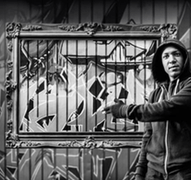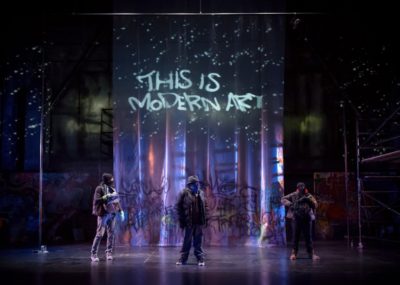This is Modern Art (based on true events)
By Idris Goodwin and Kevin Coval
Directed by Lisa Portes
Produced by Steppenwolf Theatre
Modern Art Could Have Gone a Lot Deeper
By now, you may be aware of the controversy surrounding Steppenwolf’s new play This is Modern Art and the hostile response it received from other critics. The show is part of Steppenwolf’s program for young adults, meaning high school students, and is a hagiographic depiction of the graffiti artists who painted on the modern wing of the Art Institute five years ago. After a few days of observing the controversy (and I didn’t plan it this way, but am glad other critics went first), I’ve found it to be much more interesting than the play itself, which is a story of martyrdom for the sake of paintings that have not inspired this kind of discussion on their own.
We meet a group of friends who call themselves MLU, for “made you look” who delight in spraying their pseudonyms and group name on surfaces throughout Chicago. Seven, played by Jerry Mackinnon, takes his name from Chinese astrology and numerology, and turned to graffiti because he couldn’t afford art school. The subtly named JC (J. Salomé Martinez Jr.) is a poet and dreamer who experiences painting as a mystical event. Dose (Jessie D. Prez) is a combative buffoon who I think is meant to be endearing. They take great pride in their skill, and Seven is offended when one night at a house party, Art Institute students challenge his argument that it is unfair for his work not to be in the museum. First, because art museums do display street art, and also because the main point being expressed through graffiti is contempt for the owners of whatever is being painted on, as well as the concept of owning property more generally.
Seven also meets Selena (Kelly O’Sullivan), a white girl who has access to her parents’ car, and begins dating her. He and his friends introduce her to street art, and explain that they regard themselves as inheritors of Mexican mural painters and appreciate Caravaggio’s shading technique. There is a hidden subculture of painters who observe each other’s work, which the MLU crew is proud to consider family. Seven has the idea of making the wall of the Art Institute their greatest masterpiece, and though JC is displeased with taking such a risk in response to some stranger at a house party, he agrees to it because he thinks he is beautifying the city and wants to prove to the Art Institute that what he does is a daring expression of his truth, and deserves the space just as much.
They succeed in elaborately tagging the building, but the penalty if they are caught is harsh: five years in prison and a million dollar fine. Forced into hiding, the friends are separated from each other, and cut off from their chosen world. It’s a grim fate, so the play can hardly be accused of pretending graffiti art has no consequences. One of the protagonists dies, although the staging of this scene is confusing and his fate remains unknown to the other characters, so they never explicitly say what happened.
Besides my problem with the directing in that scene, the show is for the most part designed well. Brian Sidney Bembridge’s minimalist set includes examples of tagging, as well as a reproduction of the Art Institute’s unsolicited piece. It incorporates the backstage architecture, which theatre practitioners are familiar with but retains some mystique for casual patrons and high schoolers, and contributes to the idea of the world as stage awaiting its backdrop. The four friends are played realistically, while Brittani Arlandis Green and Chris Rickett depict everybody else as caricatures. And that’s where this play’s viewpoint becomes controversial.
You could see Seven and his friends as tragic figures: their painting the Art Institute was as much about ego as art. The problem is ego is usually their only cause. Graffiti’s defenders point to the paintings by Banksy to show they’re real artists, but Banksy actually communicates ideas, whereas it’s made clear Seven and his friends at their most intricate are just painting their names, and in a way that is only jockeying for status in their own secretive clique instead of engaging with the broader world. When a tag on a train is deliberately cryptic, the only message most people receive is “I breached security,” but the play doesn’t seem interested in what most people perceive these artists to be expressing. There’s a montage of one-sentence long reactions to the Art Institute piece, and Seven blows of Selena’s complaint about people vandalizing her uncle’s business by saying his artistic skill is superior to whatever is displayed there now. Maybe, but that’s for the uncle to decide.
Steppenwolf has a notice on their website that says they do not advise for content, and if you have questions, ask patron services. That’s because it is understood that by entering, people agree to see things they would not tolerate in their own space. When asked to think of the graffiti I found most noticeable in the talk-back, I thought of the swastika somebody painted on the sidewalk outside my childhood house. One of the show’s biggest grievances is that graffiti can legally be treated as terrorism, but if most of the extremist and totalitarian symbols that commonly deface public and private property were serious expressions of the artists’ beliefs, they might approach terrorism, and whether the graffers regard themselves as part of a gang isn’t particularly relevant. Of course, most of the leftists with spray-paint cans are not nearly as serious as the racists, but they can’t have it both ways. And Seven mentions tagging condominiums, so he’s not the “good” kind of graffer who avoids harassing people where they live.
The scene most people have the biggest problem with is when Seven, Dose, and JC directly address the audience to give detailed instructions on how to covertly paint graffiti, including what sort of gloves to use, how to arrange your cans for easy access, how to use your look-out, and what supplies you’ll need if you get arrested. This scene serves no dramatic purpose and blatantly tells the teenagers in the audience to emulate the characters in how they express themselves. But art isn’t just expressing yourself into a void, it’s a dialogue, and at the talk-back and subsequent arguments on Facebook, I’ve noticed the defenders of the show and graffiti tell the majority of the public, who I think the other critics speak for, that their responses are irrelevant to minority youth and the show isn’t meant for the kind of people who go to Steppenwolf or live in its neighborhood. Well then why demand visibility if you aren’t interested in being seen by the people there?
I’m twenty-two; I know it’s exasperating to be ruled by people who see the world through experiences that happened before you were born and ideas that have been discredited. There’s a widespread theory that the crime wave of the 70s-90s was caused by lead exposure, and it is therefore unlikely to be repeated, and the laws and attitudes dating from that time are in bad need of reform. Caravaggio probably killed more people than any punk you’ll ever meet. But people under twenty-five do not own a monopoly on interpreting symbols, and truthfully, the vast majority of graffiti is hate speech, gang propaganda, or crass vanity, not art so good it’s worth abolishing property for. And most people still reject anarchism and consider property the basis of democracy. People clinging to the far left are as Carboniferous as people who believe in superpredators. The graffiti outside my current residence says “forgive.” I don’t feel threatened by its method of delivery. I don’t’ think it’s profound, either. See this show if you’re interested in what everybody was talking about on Monday.
Somewhat Recommended
Jacob Davis
For more information, see This is Modern Art’s page on Theatre in Chicago.
Playing at Steppenwolf Theatre, 1650 N Halsted, Chicago. Tickets are $20, with discounts for students. Call 312-335-1650 or visit Steppenwolf.org. Public performances are Friday and Saturday at 7:30 pm through March 14. Running time is eight-five minutes with no intermission.


